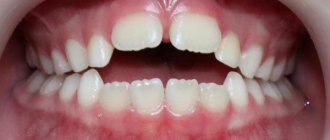June 14, 2016
Averyanova Sveta
As the child grows up, new words appear in his speech, the number of which increases every day. Parents, undoubtedly, rejoice at the achievements of their child, while not paying due attention to the pronunciation of certain or other letters.
This is how the child develops a habit of incorrect pronunciation of words, which will be difficult to correct in the future. Therefore, it is necessary to pay due attention to correcting this defect even when it is just beginning to be traced.
Reasons for incorrect pronunciation
Incorrect pronunciation of hissing and whistling sounds is called sigmatism.
The reasons why it may appear are various. The most common ones are the following:
- Features of the structure of the articulatory apparatus: shortened frenulum, “Gothic” palate (when the child has a high arch of the hard palate), structural defects of the jaw (bad bite), nasopharynx.
- Weak innervation of the tongue muscles, or, on the contrary, high muscle tone.
- Impaired phonemic awareness.
- Delay in the development of the child’s nervous system.
Problems with sound pronunciation can also appear against the background of imitating the incorrect speech of an adult. It is important that the child hears correct, clear speech not only in lessons with specialists, but also at home.
Sibilants in a child's speech
Hissing ones include - [w], [zh], [h`], [sch`]. The formation of their correct pronunciation occurs between the third and fifth years of the baby’s life.
Incorrect pronunciation of “Sh”: types, reasons
Distortion or complete absence of sibilants in a child’s speech is called sigmatism. Depending on the type of incorrect placement, there are 4 types of sigmatism:
- Parasigmatism is a stable replacement of [sh] with another sound. Labial-dental - dental - replacement of [w] with [f]. Prizubny - replacing [w] with [t]. Hissing - replacing [w] with [sch]. Whistling - replacing [w] with [s] or [z]. Occurs with malocclusion or impaired phonemic hearing. Example: hat - slipper.
- Interdental sigmatism is the same “lisping” sound. Occurs due to a shortened frenulum or narrow soft palate.
Lesson with a specialist
- Lateral sigmatism - the sound [w] does not sound firm, as it should, but squelching, as if the baby had taken water into his mouth. Observed due to lateral open bite or weak tongue muscles.
- Nasal sigmatism - in a preschooler, the back of the tongue becomes very tense, and [w] can be pronounced with a nasal “echo.”
Before figuring out how to teach a child to pronounce the letter w, you should understand the reasons for the violation. Often a routine visit to the orthodontist, during which the bite or upper palate is corrected, ends with the long-awaited “hissing” of the baby. Otherwise, there is a need to develop the correct articulation pattern in speech therapy classes.
Articulation gymnastics for staging hissing
Before requiring the baby to pronounce a hissing sound, it is necessary to carry out preparatory articulatory gymnastics. Its duration is no more than 10 minutes. Despite the fast pace (so that the preschooler does not get bored), the child must perform each exercise carefully, since gymnastics directly determines how quickly a child can learn to say the sound [w].
Main tasks in articulatory gymnastics:
- Fence - a wide smile with teeth.
- Tube - the lips are gathered into a tube, there is a small gap between the lips.
- Alternating fence - tube.
- Hippopotamus - open your mouth wide and hold it for a while.
- Spatula - place a wide, outstretched tongue on the lower lip. You can “bite” with your tongue to make it wider.
- Homemade jam: lick the upper and then the lower lip with the tip of your tongue.
- Brush - move the tip of your tongue across the soft palate - from the throat to the teeth and back.
Articulation gymnastics
Tasks to determine the position of a sound in a word
At the beginning of the lesson, you can also develop phonemic awareness - determine the position of a sound in a word. To do this, you will need rich verbal and subject material.
- The child is asked to clap if he hears the “snake song (sound [sh]).” In this case, words are pronounced that contain the desired sound or do not contain them. You should not pronounce words with other hissing or mixed whistling sounds.
- The child is given a small sign with 3 windows indicating the beginning, middle and end of the word. And also a chip (cube/drawn sound). The teacher says the condition: “I will name the word, and you put the chip where the sound [w] is located.”
What to do if a 5-year-old child speaks poorly
Gymnastics for clear pronunciation
To correctly pronounce hissing sounds, speech therapy uses articulation and breathing exercises in combination. In this case, you should definitely remember about the correct position of the organs of articulation: lips and tongue.
Additional Information! Breathing exercises are aimed at developing smooth exhalation. To teach your child to perform breathing exercises, you need to create bright and interesting didactic material. For example, a flower with a butterfly sitting on it, which, according to the terms of the task, needs to be blown away.
Methodological basics for parents
It is important to know the correct position of the tongue and lips when pronouncing a sound in order to work on the exercises at home.
- Lips in the “tube” position;
- The tongue is wide, the tip is raised upward;
- The lateral parts of the tongue are in contact with the teeth of the upper jaw;
- A small gap forms between the palate and the tongue in the area of the upper incisors.
Articulatory position of the sound Ж
The articulation of the sound Ж is similar to the position of the sound Ш, but with the only difference - in the first case it is necessary to pronounce with the addition of a voice (the ligaments are tense), otherwise the characteristics are the same:
- The lips are slightly forward, rounded, as when producing the sound O.
- The back of the tongue is raised towards the back of the upper palate.
- The tip of the tongue is directed upward towards the alveoli, located behind the front teeth.
- The side of the tongue rests on both sides of the molars.
What to do if the child does not pronounce “w”?
When pronouncing a voiced “zh,” the vocal cords are involved. The exhaled stream and the tension of the tongue during sound are weak. The tip of the tongue trembles and vibrates a little under the influence of the air stream. If the child’s tongue is not mobile enough or is sluggish, then specially selected preparatory exercises are necessary.
The sound “zh” is complex in its articulation, so children master it relatively late and often pronounce it incorrectly or unclearly even by the end of preschool age. There are several options for incorrect pronunciation of this sound: either it is completely missed, or pronounced unclearly, or replaced with another (most often “z”).
Violation of the sound “zh” is in most cases correctable, and often this deficiency is eliminated relatively easily. But an indispensable condition is the regularity, systematicity of the exercises and the desire of the child himself to correct his speech and begin to pronounce “w” correctly.
Before starting classes, you need to check whether the baby’s phonemic hearing is sufficiently developed, that is, whether he can distinguish hissing sounds from other, similar sounds. To test and train phonemic awareness, it is useful to ask the child to come up with words with the sounds in question. Select pictures whose names contain these sounds, and work out with your child the meaning of words that differ in one sound.
Warm up for the tongue
To better pronounce sounds, you can use a tongue warm-up, which consists of the following exercises:
- First, we round the lips, the teeth do not close, the edges of the tongue are pressed against the teeth, and the tongue itself forms a scoop. Exhale with added air while making a hissing sound.
- Spread your tongue wide, bend its tip and stick it out with raised side edges.
- Raise the protruding tongue alternately to the upper and lower teeth, to the upper and lower lip.
- “Accordion” to strengthen the muscles of the tongue in a vertical position: open your mouth, smile, and press your tongue to the roof of your mouth, open and close your mouth 5 times.
- “Pie”: open your mouth and smile, curl your tongue, lifting the edges, count to 15, and then repeat.
These exercises can also be used when training the pronunciation of other sibilants.
Warm up for lips
Lips play an important role when pronouncing hissing words. They should stretch forward with their proboscis. But it is not possible to give such a shape to the lips right away. You will have to resort to articulation exercises again:
- lips slightly rounded;
- “smile” - smile so that the upper and lower teeth are visible and hold this position for 7 seconds;
- “tube” - stretch out the lips with a tube.
You should follow the norms of breathing exercises, as well as exercises related to the production and automation of the sound “zh”, since these exercises are quite tiring for the child and can cause dizziness due to hyperventilation.
Basic methods for producing the sound “zh”
Staging sound is the development of new connections in the child and the inhibition of previously incorrectly formed ones. Methods that can help make the sound “zh” include:
- The first method is by imitation , when the child’s attention is focused on the movements and positions of the articulatory apparatus.
- The second method is mechanical. It is used when the child lacks visual, auditory and tactile-vibration control.
- The third method is mixed , when all possible methods are used to achieve the final goal - establishing the correct pronunciation of an isolated sound.
With all these methods of producing any sound, verbal instructions, kinetic sensations, visual, auditory, tactile-vibrational control and reference sounds are always used.
To train the letter “zh” you can resort to the following exercises :
- Pure saying: “ZHA-ZHA-ZHA. We saw a hedgehog. ZHA-ZHA-ZHA. The hedgehog has spines. ZHA-ZHA-ZHA. I found a hedgehog. ZHI-ZHI-ZHI. Hedgehogs live in the forest."
- The child must learn to form the plural of nouns - garage-garages, knife-knives, snake-snake, etc.
- “The beetle is buzzing” - the child needs to imagine how the beetles are buzzing and imitate this sound. The position of the lips should be correct - rounded and slightly pushed forward. The wide part of the tongue rises to the tubercles behind the upper teeth, and a warm air stream should come out of the mouth.
You can see how speech therapists work with children to produce the sound “zh” in this video:
Incorrect pronunciation of sound: types of sibilant sigmatism
Sometimes parents of a child who has problems with sound pronunciation turn to a speech therapist late for help. Or they even think that the baby has no problems with speech, due to the fact that they do not always know how this or that sound should be reproduced correctly. Each sound has its own articulatory position. By ear, it may seem that the child seems to pronounce it (doesn’t miss it or replace it, just “F” is heard), but at the same time he doesn’t always articulate it correctly.
The work is carried out individually, depending on the characteristics of the violation. There are several types of hissing sigmatism, characterized by incorrect position of the organs of the speech apparatus:
- Lower (the sound is softened).
- Rear-lingual (in this case, the position of the articulatory organs is as with the sounds G, X; this leads to the fact that the sound Z is pronounced noisily).
- Buccal (in this case, the tongue is motionless, the cheeks are puffed out, the teeth are closed, and a dull, booming sound is formed).
Examination of the pronunciation of the sound “Ш”
When examining pronunciation, a specialist must find out how the sound being tested is pronounced separately, in words, in speech. For this purpose, images whose names include “Ш” can be used. It is important that it occupies different positions and combines with other sounds. The little student is asked to recite a poem in which the words have an "W".
If a child does not clearly pronounce an isolated “Sh”, you must first introduce this sound, and then consolidate its pronunciation in speech. If a child correctly pronounces a separate sound, but the defect is observed only in words, you need to work on consolidating it in speech.
Rules for testing at home:
- The child is in a calm state, repeating the necessary words after one of the parents. When forced into pronunciation, the sound is often distorted.
- The child pronounces the desired sound more than once. Sometimes children, even if they have a defect, can imitate the correct sound and the violation is not immediately noticed. It is easier to hear defective pronunciation in words where “Ш” is pronounced together with other consonants. To check, the child should pronounce the following words: chestnut, muffler, punch, mouthpiece.
For some children, the problem can be overcome in the first lessons; for others, the defect is dealt with step by step over some time, selecting appropriate tasks and techniques.
Prevention of sound pronunciation correction and prediction
In addition to the speech therapy classes that the child attends in kindergarten or speech school, homework to eliminate speech disorders and sound correction is also recommended. Additional work with parents will help reinforce the material covered.
The teacher can invite parents to perform some exercises from a complex of articulation or breathing exercises with their child at home. If the baby still does not always correctly differentiate the sound, and in free speech replaces it with a similar sounding one, then adults are recommended to focus on this, offering the correct option.
Thus, work on correcting sound pronunciation will be carried out continuously: in the garden, on a walk, at home, which will lead to positive results.
The sooner speech therapy work begins, the sooner speech will become correct and all sounds will be brought to automatism.
Video on the topic
How to teach a child to pronounce the sound Ш at home:
Thus, some children have difficulty pronouncing hissing sounds, in particular Sh. This may be due to the incorrect structure of the articulation organs and weakness of the tongue muscles.
In order to teach a child to pronounce words with the letters Ш, it is necessary to perform special exercises with him every day. You can become familiar with the features and techniques of conducting classes by watching a training video on the Internet.










